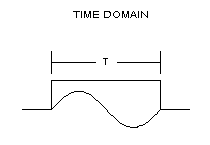Home Page or Table of Contents
FREQUENCY RESOLUTION -- Obtainable frequency resolution is equal to the inverse of the time duration during which a signal is being observed, i.e., 1/T:

This is equivalent to saying that, in order to obtain a certain (deterministic) frequency resolution, one must be able to observe a least a single whole cycle (T) of a sine wave at the resolved difference frequency:

Today's widespread use of digital signal processing has made what should be a simple truth into an often tortured manipulation of multiple variables -- "... frequency resolution is equal to the sample frequency divided by the number of points in the Fourier transform -- but are the data real or complex, and are we at baseband or at I.F. ??" Whatever answer is obtained, it can be verified by comparing it to 1/T!
TIME RESOLUTION -- Obtainable time resolution is equal to the inverse of the bandwidth used to observe the signal at baseband, i.e., 1/f:

For a discussion of the ambiguity between bandwidth and highest frequency, see Nyquist Criterion
Note that the definitions for FREQUENCY RESOLUTION and TIME RESOLUTION are purely analog definitions, but nevertheless, one hopes, remain true for digitally sampled systems.